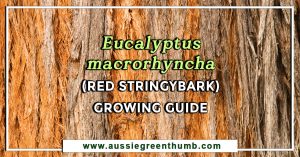Trees hold history and great stories, and this is incredibly true of the Pencil Pine which has a rich Mediterranean history. In our how to grow and care guide, we’ll introduce you to the pencil pine and its varieties, share how to propagate your own tree and tips on caring for it, cover some pests and diseases, and wrap up with some frequently asked questions about this sought after tree.
More...

Family: | Cupressaceae |
|---|---|
Genus: | Cupressus |
Species: | C. sempervirens |
Common Names: | Pencil pine, Mediterranean cypress |
Location: | Outdoor |
Type: | Tree |
Growth: | Up to 15 metres tall and 1.5 metres wide |
Sun requirements: | Full sun |
Foliage Colour: | Dark green |
Flower Colour: | Green |
Flowering: | Spring |
Maintenance level: | Low |
Poisonous for pets: | No |
Introducing Pencil Pine
The Mediterranean cypress or Cupressus sempervirens is an evergreen tree that is shaped much like a pencil. The dark green leaves have a welcoming scent to them. Pencil pine is known for being hardy and handles drought like a pro along with a light frost.
If you have ever seen a Mediterranean cypress you will understand why it’s so popular with landscapers and garden designers. It does well in a formal garden but also in gardens with limited space.
Gardens and landscapes of the Mediterranean feature plenty of these tall and narrow beauties, and it’s native to the Eastern Mediterranean. The tree doesn’t enjoy cold wind, which shouldn’t then surprise you that Mediterranean cypress likes full sun especially if the weather is cold.
Pencil pine also doesn’t do well in a high rainfall area. Low maintenance is guaranteed with this tree which does perfectly fine without fertiliser or pruning. Some of the varieties are better at keeping their narrow shape than others. Cupressus sempervirens doesn’t struggle much with pests and disease aside from cypress aphids.
Pencil Pine Varieties
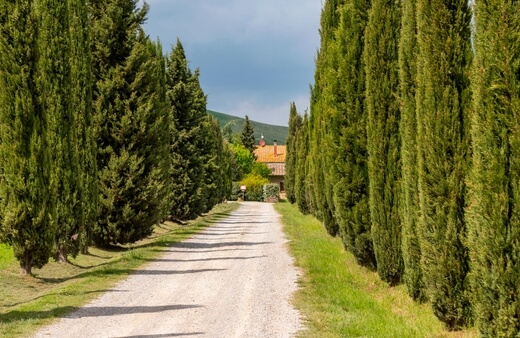
Cupressus sempervirens ‘Stricta’
This cultivar is the one most commonly planted and can be spotted in formal gardens, in parks, cemeteries, and along the roadside. The leaf colour is either dark green or sometimes blue green and the tree produces cones after about 10 years.
Cupressus sempervirens var. horizontalis
This is more open and has a spread out form with horizontal branches.
Cupressus sempervirens ‘Swane's Golden’ or ‘Swane's Gold’
It has a shape that is similar to the Stricta but it doesn’t grow as quickly. Any new growth on the tree is yellow and this then becomes green within 5 years.
Other variegated forms include:
- Swane's Variegated - green leaves with yellow spots
- Aurea – a yellow green colour
- Gold Rocket – a pale golden colour
- Variegata - white and light yellow variegations on the leaves.
Compact forms include:
- Tiny Tower - blue-green leaves, narrower, shorter and more compact than 'Stricta'.
- Tito - a dwarf variety that grows like a pencil.
- Cereiformis - short, very narrow shape with thick leaves.
- Contorta – the branches are twisted and it’s slow growing.
- Fortusellii - dwarf cultivar, shrub like and compact, with short and upright branches
How to Grow Pencil Pine Tree
Pencil pine is quite adaptable when it comes to soil type. As long as it’s well draining, the soil can be sandy or clay. The ideal time to plant pencil pine is during the spring. You’ll need to keep the tree well watered, especially during dry weather, for its initial growing seasons.
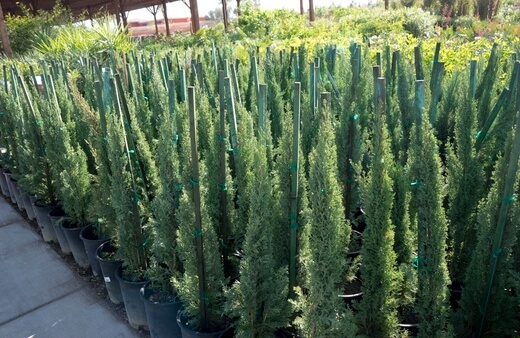
Propagating Cupressus sempervirens
It is possible to propagate pencil pine using a cutting. The best time to take the cutting is from the middle of summer to the beginning of autumn. You’ll need some sharp pruning scissors to cut off a long branch from the bottom of the tree.
You can then divide the branch into a few cuttings. Just ensure each cutting has at least 3 sets of needles. When making the cuts, make sure the top cut is straight, and the bottom one at a 45 degree angle.
Fill a container with a mix of garden soil and coarse sand, and water it all the way through but make sure it isn’t drenched. Remove the needles from the lower part of each Mediterranean cypress cutting but don’t touch the ones at the top.


Get Your Free Guide:
Master Growing Australian Natives eBook
A Must Have Complete Guide for Every Australian Garden
Get Your Free Guide:
Master Growing Australian Natives eBook
A Must Have Complete Guide for Every Australian Garden
Dip the bottom end of the cutting (the one with the cut made at an angle) into rooting hormone and then plant into the prepared container. Cover the container with clear plastic and tie it closed. You can place the container outside in a spot that is sheltered from the hot sun, wind and cold.
If you opt to keep the cuttings indoors, you can choose a place that is cool and humid. Each day you’ll need to take off the plastic and mist the soil. It takes about a year for the cuttings to be ready for outdoor planting.
Caring for Mediterranean Cypress
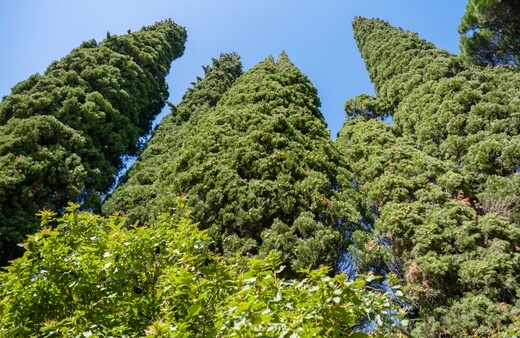
Sunlight
Cupressus sempervirens needs full sun, preferably 6 or more hours each day to optimise growth and wellbeing.
Soil
Mediterranean cypress is happiest when planted in a well-draining soil. The tree likes to grow in soil that is consistently moist. Try to stay away from soils that are heavy and that become waterlogged in winter as you are trying to find the right balance between good drainage and maintaining the right moisture levels.
Using a mixture of clay, loam and sand would probably provide the right environment. When it comes to pH, the soil can be alkaline, acid or neutral.
Watering
You’ll need to keep your tree well watered during any dry seasons, especially while the pencil pine is still establishing itself.
Possible Pencil Pine Pests and Diseases
Spider Mites
Spider mites have the potential to cause great damage to trees only because they generally appear in large quantities. These pests operate by sucking chlorophyll out of the leaves which then creates tiny white dots on the leaf surface.
If you are dealing with a spider mite infestation, you might notice that the leaves of your pencil pine turn yellow or brown and start dropping off the tree. Also look out for a type of silk web over the leaves.
Your first line of defence is using a watering hose to spray the tree and try to move some of the spider mites along. This is more efficient if the tree is small. Don’t be afraid to apply some decent pressure.
Spider mites enjoy dusty conditions so spraying your tree now and then to keep the environment less welcoming can only help. You can also use horticultural oils and insecticidal soap for treatment.
Neem oil for example is a great treatment for many garden ailments. Be sure to follow the guidelines on the product to avoid aggravating the problem and potentially damaging your tree. Often these organic products need a few applications per season.
Refer to our guide to know more about different types of neem oil and how to use them.
Cypress Aphids
This nasty pest is another sap sucker which actually injects poison into the plant or tree. They are tiny, have a yellow to brown colour and are covered with tiny hairs. Evidence that you are dealing with cypress aphids could be that the new tree growth is yellow during the summer months and by the end of the season, they become brown and die off.
The lower parts of your Mediterranean cypress might be more affected than the upper parts. This pest can also cause sooty mould to grow on the new shoots and leaves. You can once again use insecticidal soaps and oils for a natural treatment solution.
You can use plant-based oils like neem or canola oil. These types of products actually smother the aphid, and you’ll need to make sure that you cover the affected leaves and parts of the tree well.
Pencil Pine Frequently Asked Questions
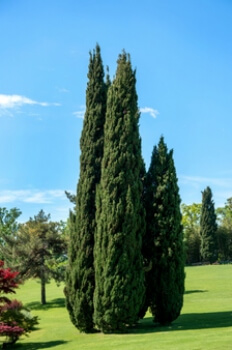
What is the wood of the Mediterranean cypress used for?
The wood has a fragrance which makes it resistant to insects and fungi. Pencil pine wood is great for underwater use which makes it popular for shipbuilding. It has also been used to create furniture and home features.
Does the pencil pine have any special uses?
Cupressus sempervirens has become vital in reforestation projects. This is because the tree is able to handle dry and poor quality soil. Pencil pine is also used to create firebreaks and windbreaks in coastal areas.
How quickly does the pencil pine grow?
This is definitely considered a fast growing tree, especially when it’s just starting out. The average growth is around 60 cm per year.
Does Cupressus sempervirens have any medicinal uses?
The tree is in fact used for various remedies the world over. It works well as an antiseptic and to treat fever, among other ailments.
How long does a Mediterranean cypress live for?
These trees generally enjoy a good long life, and there are some that are more than 1000 years old.
What are some of the health benefits of using pencil pine oil?
Cypress oil is great for relieving muscle pain and cramps, and also stimulates blood flow. The oil is detoxifying and helps to drain the body’s lymphatic system.
Sign up for our newsletter and achieve garden perfection with our tips, reviews and advice on all things green.Wrapping Up Our Pencil Pine - Cupressus sempervirens Growing and Care Guide
A hardy tree that has the potential to be both compact and stately, is a real garden treasure. The pencil pine is low maintenance, yet promises many years of joy. It can be pruned just for shape if necessary, is drought tolerant, and doesn’t struggle much with pests and diseases. I think it deserves a green thumbs up!
Published on March 7, 2023 by Maisie Blevins
Last Updated on February 23, 2025




